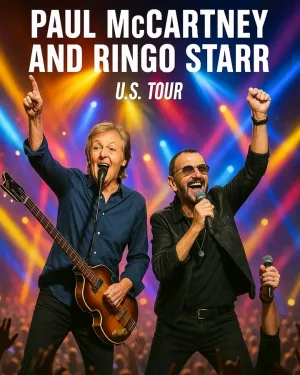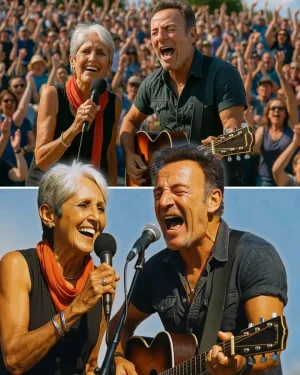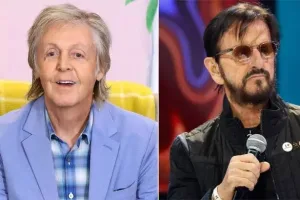**Historic Revival at the Festival: A Night of Nostalgia, Innovation, and Heartfelt Tribute**
In an extraordinary event that blurred the lines between reality and technology, music lovers around the world witnessed what many are calling one of the most groundbreaking performances in recent memory. The festival grounds erupted into awe and emotion as legendary musician George Harrison took the stage under a dazzling canopy of golden lights, setting the scene for an unforgettable night of musical magic.
Harrison, known for his soulful guitar work and poetic lyricism, appeared to be channeling a different era—one that combined the timeless appeal of classic rock with cutting-edge holographic technology. As he launched into a heartfelt rendition of “While My Guitar Gently Weeps,” the crowd was transported to a different time, yet firmly rooted in the present. His falsetto soared through the night air, slicing through the darkness like a spark, igniting an energy that was both nostalgic and exhilarating.
The evening’s centerpiece came with the iconic opening chords of the Bee Gees’ “Stayin’ Alive.” The unmistakable disco anthem reverberated across the festival grounds, and suddenly, hundreds of bodies moved in unison, lost in the euphoria of pure disco bliss. Young fans swayed alongside longtime devotees, unified by the irresistible groove and the universal language of music. The scene was a vibrant celebration of timeless pop culture, a testament to the enduring influence of the Bee Gees’ legacy.
But the most astonishing moment was yet to come. As the chorus reached its peak, Barry Gibb, the last surviving member of the legendary trio, stepped into the spotlight. His voice, rich with emotion, filled the night sky, and just as he reached the final notes, the stage shifted in an unexpected way. A spotlight suddenly moved to the wings, and from the darkness emerged a stunning hologram—an eerily realistic, shimmering image of Robin Gibb, the legendary singer who passed away in 2012.
Robin’s holographic figure appeared beside Barry, singing in perfect harmony, his voice blending seamlessly with the living legend. The crowd gasped collectively, a mixture of awe and tears welling in their eyes. For a moment, it felt as though Robin had been resurrected—his spirit alive and singing once more, bridging the gap between life and legacy. The hologram’s performance was so convincing that many thought they were witnessing a miracle.
This unprecedented spectacle was more than just a technological marvel; it was a heartfelt tribute. The hologram of Robin was a love letter to fans, a gift from the Gibb family and the event organizers to honor the enduring memory of Robin Gibb and the timeless music of the Bee Gees. It was a hauntingly beautiful reminder that some artistry is immortal, transcending the boundaries of mortality.
The audience’s reaction was a wave of emotion—tears streamed down faces, and voices choked with sentiment. Social media erupted with praise and wonder, as viewers around the globe shared videos and stories of the night that felt both surreal and profoundly real. Critics hailed it as a pioneering moment in live performance, blending nostalgia with innovation in a way that had never been attempted before.
Concertgoers described the experience as “transcendent,” “heartwarming,” and “a moment that will be remembered for generations.” Many expressed hope that this technology could be used to revive other legendary artists, giving fans a chance to hear their voices once more, and to celebrate their legacies in ways previously thought impossible.
As the night drew to a close, the festival attendees left with a sense of awe, knowing they had witnessed history. It was a night that redefined live music, blending the past and present into a seamless tapestry of sound and sight. The resurrection of Robin Gibb—through the magic of holography—served as a testament to the power of music to heal, inspire, and preserve the memories of those who touched our lives.
In a world constantly evolving, this event proved that some legacies are eternal—living on through the innovative spirit of those who refuse to let their stories fade away. The night the Bee Gees returned, in spirit and song, was a reminder that true artistry never dies; it simply waits to be rediscovered, reimagined, and celebrated anew.



